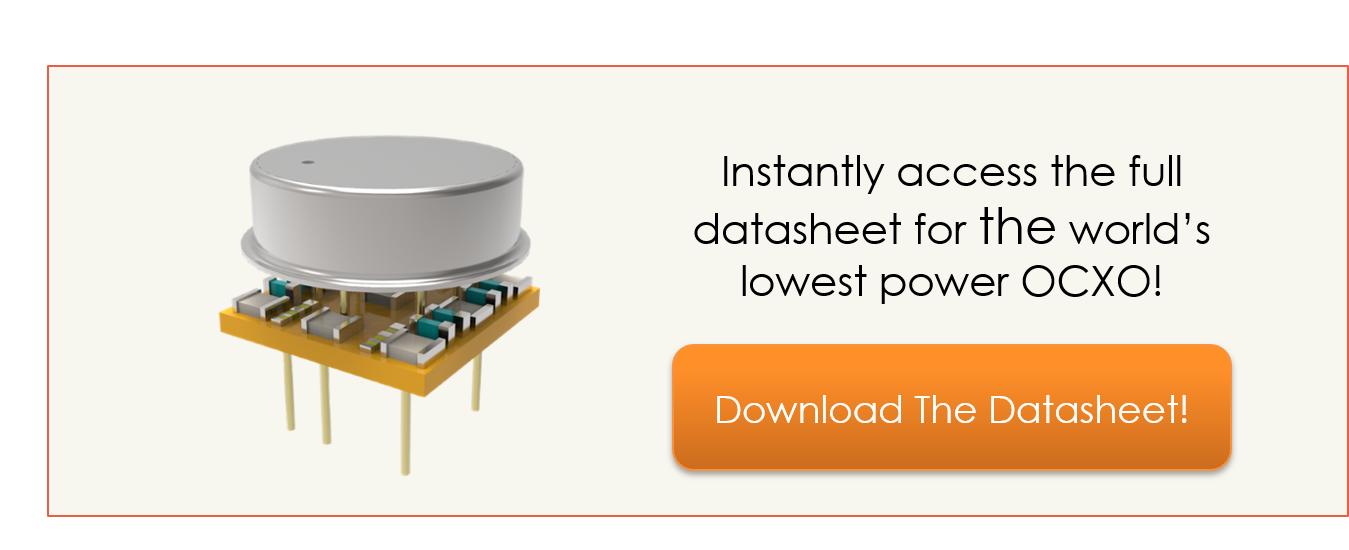
"You say you want a revolution
Well, you know
We all want to change the world"
-The Beatles
Ok, maybe The Beatles weren't singing about a Low Power OCXO Revolution, but trust me, there's indeed a revolution happening right now in the ocsillator Industry...
High Demand for Low Power
With the growing need for oscillators to have good stability and low power requirements, several companies in the RF industry are looking towards newer technologies to fill this void. Luckily, these newer technologies are beginning to appear throughout the tech market.
These new technologies we're talking about are “Low Power Oven Controlled Frequency Oscillators.”
What a mouthful that is…
How about we just refer to them as "LP OCXOs"? Much better!
Let's dive deeper into why LP OCXOs are growing in demand within the Oscillator and RF world. We'll also discuss the top LP OCXOs in the tech market as well as why an LP OCXO may work perfect in your applications.
Let's start by comparing OCXOs with Temperature Controlled Frequency Oscillators (TCXOs) and LP OCXOs.
Differences between TCXOs, OCXOs, and LP OCXOs
TCXOs are commonly used for reference and local oscillator needs in low power situations. Unfortunately, they tend to only have moderate temperature stability, OK short term stability, and decent phase noise. OCXOs offer great improvement in these areas but it comes at a cost. That cost is power. While TCXOs have a current draw of around 2 – 20 mA, an OCXO normally pulls 150 – 300 mA with a startup or “warming” current of 200 – 600 mA. The majority of that power is consumed by the OCXO's oven (learn more about the anatomy of OCXOs here).
The future is here in the form of Low Power OCXOs. These units try to harness the best of both worlds. They have nearly as good stability and phase noise performance as TCXOs and at a fraction of the power “cost” of OCXOs.
Best Uses for Low Power OCXOs
LP OCXOs can be used in a wide variety of applications. Some great examples include use in:
- Mobile test equipment devices
- Medical equipment including MRI devices
- Military drones and Unmanned Aerial Vehicles (UAVs)
- Various transmitters and receivers
- Other Military Devices
- Synthesizers
- System Clocks
- Phase Lock Loops
Where to find the best LP OCXOs for your application needs
The data below shows oscillators being produced by several manufacturers and how they compare according to their data sheet specifications.
Phase Noise. Phase noise performance is a big factor in many RF designs. Noise is the bane of most applications. All of the units looked at have similar performance with Bliley’s LP-N having a slight edge at a few offsets.
Temperature Stability. Over a wide range of temperatures, Magic Xtal’s MXO37/8 and MXO37/8P, are by far superior. They have been in the low power game the longest but the other manufacturers are starting to catch up. At narrower temp ranges the others may be just about as good.
Allan Deviation. If short term stability is a needed factor in your design, then Bliley’s LP-N is the top choice. Their unit specs at 8E-12 while all of the others spec at 20E-12.
Acceleration Sensitivity. If your design is going to be used in a fairly static situation, then this isn’t much of a worry. However, if vibration may be an issue, the Magic Xtal and Bliley oscillators are less sensitive and should give better performance. Bliley is also supposed to have a low power, G-compensated unit in the works.
Power Consumption. Here’s the whole point of this type of oscillator. How much power is this performance going to cost? At a steady state power drain of 135 mW, Bliley’s LP-N has a bit of a lead here. The spec that truly stands out is the startup power. The LP-N only pulls 200 mW, less than 1/3 of the nearest competitor. If you’re concerned with battery life, especially in power cycling conditions, that’s fantastic.
The Final Results
So there you have it; a summay of the main Low Power OCXOs on the market. Which will work best for you will depend on what the critical needs of your design are. For a tight temperature stability, Magic Xtal is the winner. For low power consumption, particularly at startup, Bliley has it.
Here's a chart that may help you further visualize the comparisons between the LP OCXOs:

See the Full Specifications of the LP-N Low Power Oscillator by downloading the datasheet.






